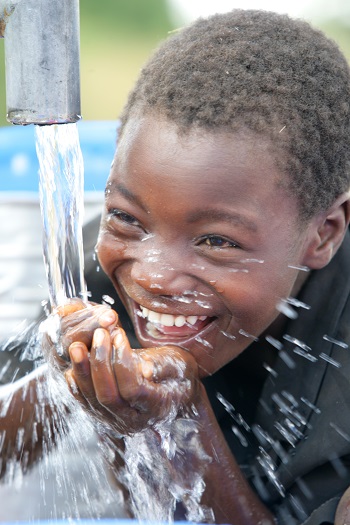2.1 billion people lack safe drinking water at home, more than twice as many lack safe sanitation
WHO, UNICEF release first global estimates for water, sanitation and hygiene for the Sustainable Development Goals
Some 3 in 10 people worldwide, or 2.1 billion, lack access to safe, readily available water at home, and 6 in 10, or 4.5 billion, lack safely managed sanitation, according to a new report by the World Health Organization (WHO) and UNICEF.

While drinking water from a hand pump, a child smiles, in Mzuzu, the capital of Northern Region and the third largest city, by population, in Malawi.
The Joint Monitoring Programme report, Progress on Drinking Water, Sanitation and Hygiene: 2017 Update and Sustainable Development Goal Baselines, presents the first global assessment of “safely managed” drinking water and sanitation services. The overriding conclusion is that too many people still lack access, particularly in rural areas.
“Safe water, sanitation and hygiene at home should not be a privilege of only those who are rich or live in urban centres,” says Dr Tedros Adhanom Ghebreyesus, Director-General, World Health Organization. “These are some of the most basic requirements for human health, and all countries have a responsibility to ensure that everyone can access them.”
Billions of people have gained access to basic drinking water and sanitation services since 2000, but these services do not necessarily provide safe water and sanitation. Many homes, healthcare facilities and schools also still lack soap and water for handwashing. This puts the health of all people – but especially young children – at risk for diseases, such as diarrhoea.
As a result, every year, 361 000 children under 5 years die due to diarrhoea. Poor sanitation and contaminated water are also linked to transmission of diseases such as cholera, dysentery, hepatitis A, and typhoid.
“Safe water, effective sanitation and hygiene are critical to the health of every child and every community – and thus are essential to building stronger, healthier, and more equitable societies,” said UNICEF Executive Director Anthony Lake. “As we improve these services in the most disadvantaged communities and for the most disadvantaged children today, we give them a fairer chance at a better tomorrow.”
Significant inequalities persist
In order to decrease global inequalities, the new SDGs call for ending open defecation and achieving universal access to basic services by 2030.
Of the 2.1 billion people who do not have safely managed water, 844 million do not have even a basic drinking water service. This includes 263 million people who have to spend over 30 minutes per trip collecting water from sources outside the home, and 159 million who still drink untreated water from surface water sources, such as streams or lakes.
In 90 countries, progress towards basic sanitation is too slow, meaning they will not reach universal coverage by 2030.
Of the 4.5 billion people who do not have safely managed sanitation, 2.3 billion still do not have basic sanitation services. This includes 600 million people who share a toilet or latrine with other households, and 892 million people – mostly in rural areas – who defecate in the open. Due to population growth, open defecation is increasing in sub-Saharan Africa and Oceania.
Good hygiene is one of the simplest and most effective ways to prevent the spread of disease. For the first time, the SDGs are monitoring the percentage of people who have facilities to wash their hands at home with soap and water. According to the new report, access to water and soap for handwashing varies immensely in the 70 countries with available data, from 15 per cent of the population in sub-Saharan Africa to 76 per cent in western Asia and northern Africa.
Additional key findings from the report include:
• Many countries lack data on the quality of water and sanitation services. The report includes estimates for 96 countries on safely managed drinking water and 84 countries on safely managed sanitation.
• In countries experiencing conflict or unrest, children are 4 times less likely to use basic water services, and 2 times less likely to use basic sanitation services than children in other countries.
• There are big gaps in service between urban and rural areas. Two out of three people with safely managed drinking water and three out of five people with safely managed sanitation services live in urban areas. Of the 161 million people using untreated surface water (from lakes, rivers or irrigation channels), 150 million live in rural areas.
Source:United Nations Children's Fund
- 313 reads
Human Rights
Ringing FOWPAL’s Peace Bell for the World:Nobel Peace Prize Laureates’ Visions and Actions

Protecting the World’s Cultural Diversity for a Sustainable Future

The Peace Bell Resonates at the 27th Eurasian Economic Summit

Declaration of World Day of the Power of Hope Endorsed by People in 158 Nations

Puppet Show I International Friendship Day 2020

